| |
WW1
Soldiers database
8th
Index
WW2
Soldiers database
Street Directories Menu
SEAC (South East Asia
Command) Magazine March 1944
sent to me by 2 people, Herbert
Coulter and
John Nodwell
thank you guys, both were great
as photos weren't clear in one of them
SEAC
Souvenir of the Arakan Epic
PUBLISHED BY THE DAILY NEWSPAPER OF SOUTH EAST ASIA COMMAND AND
PRINTED BY COURTESY OF THE STATESMAN IN CALCUTTA, MARCH 1944
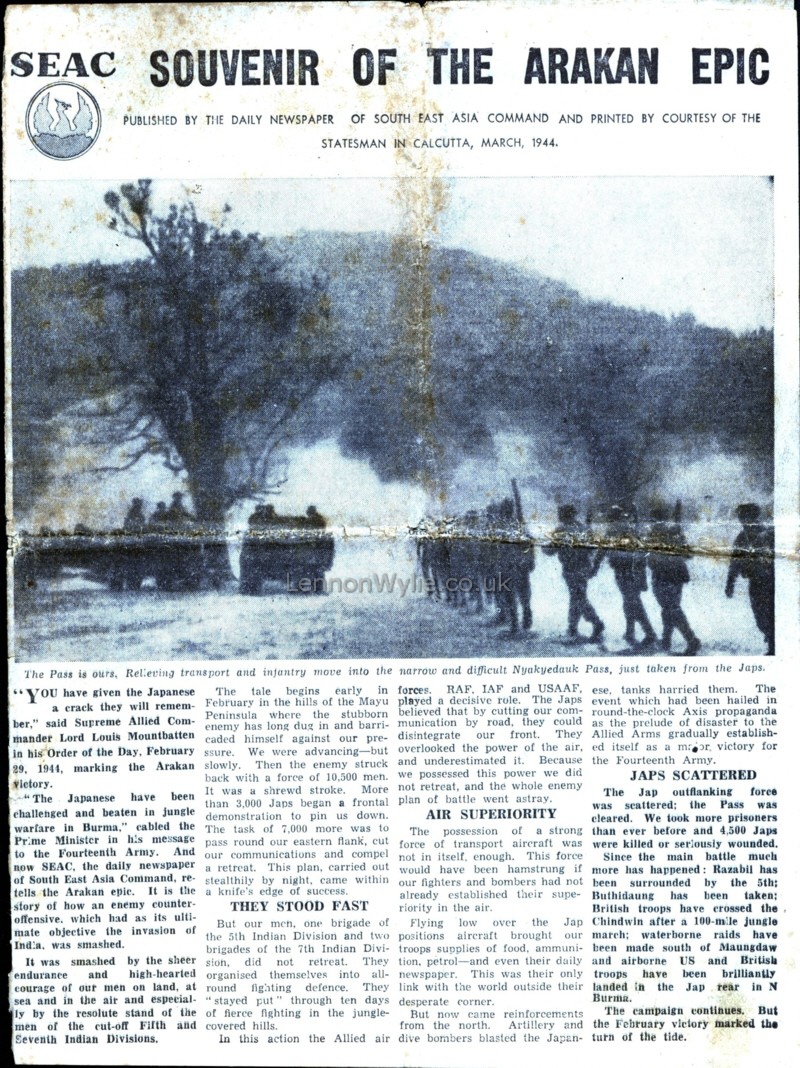
The Pass is ours, Relieving transport and
infantry move into the narrow and difficult Nyakyedauk Pass, just taken
from the Japs.
"You have given the Japanese a crack they will remember," said
Supreme Allied Commander Lord Louis Mountbatten in his Order of the Day,
February 29, 1944, marking the Arakan victory. "The
Japanese have been challenged and beaten in jungle warfare in
Burma," cabled the Prime Minister in his message to the Fourteenth
Army. And now SEAC, the daily newspaper of South East Asia Command,
retells the Arakan Epic. It is the story of how an enemy
counter-offensive, which had as its ultimate objective the invasion of
India, was smashed. It was smashed by the sheer endurance and
high-hearted courage of our men on land, at sea and in the air and
especially by the resolute stand of the men of the cut-off Fifth and
Seventh Indian Divisions.
The tale begins early in February in the hills of the Mayu Peninsula
where the stubborn enemy has long dug in and barricaded himself against
our pressure. We were advancing - but slowly. Then the
enemy struck back with a force of 10,500 men. It was a shrewd
stroke. More than 3,000 Japs began a frontal demonstration to pin
us down. The task of 7,000 more was to pass round our eastern
flank, cut our communications and compel a retreat. This plan,
carried out stealthily by night, came within a knife's edge of success.
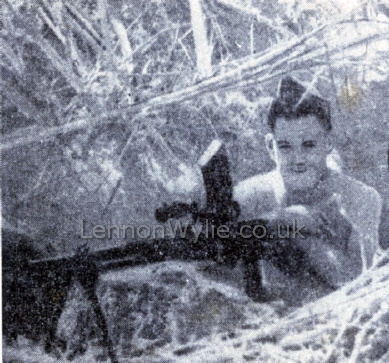
Defender of the Pass
THEY STOOD FAST
But our men, one brigade of the 5th Indian Division and two brigades of
the 7th Indian Division, did not retreat. They organised themselves
into all-round fighting defence. They "stayed put"
through ten days of fierce fighting in the jungle-covered hills. In
this action the Allied air forces, RAF, I.A.F and U.S.A.A.F, played a decisive
role. The Japs believed that by cutting our communication by road,
they could disintegrate our front. They over looked the power of
the air, and underestimated it. Because we possessed this power we
did not retreat, and the whole enemy plan of battle went astray.
AIR SUPERIORITY
The possession of a strong force of transport aircraft was not in itself,
enough. This force would have been hamstrung if our fighters and
bombers had not already established their superiority in the
air. Flying low over the Jap positions aircraft brought our
troops supplies of food, ammunition, petrol - and even their daily
newspaper. This was their only link with the world outside
their desperate corner. But now came reinforcements from the
north. Artillery and dive bombers blasted the Japanese, tanks
harried them. The event which had been hailed in round the
clock Axis propaganda as the prelude of disaster to the Allied Arms
gradually established itself as a major victory for the Fourteenth Army.
JAPS SCATTERED
The Jap outflanking force was scattered; the Pass was
cleared. We took more prisoners than ever before and 4,500
Japs were killed or seriously wounded. Since the main battle
much more has happened: Razabil has been surrounded by the
5th: Buthidaung has been taken; British troops
have crossed the Chindwin after a 100-mile jungle march;
waterborne raids have been made south of Maungdaw and airborne US and
British troops have been brilliantly landed in the Jap rear in N.
Burma. The campaign continues. But
the February victory marked the turn of the tide.
|
| PM's
MESSAGE TO THE FOURTEENTH
The Prime Minister sent this message to Lord Louis Mountbatten, Supreme
Allied Commander : "I congratulate you and the
Fourteenth Army heartily upon the successful outcome of the series of
fierce encounters with the Japanese in Arakan. It must be a
great satisfaction to all ranks and races engaged in our common effort
that the Japanese have been challenged and beaten in jungle warfare in
Burma, and that their boastfulness should have received a salutary
exposure."
|
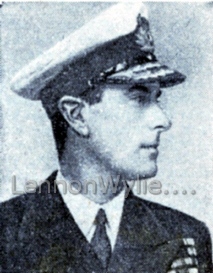
Lord Louis Mountbatten |
"I SALUTE YOU"
The Supreme Allied Commander issued
this for publication in SEAC on February 29, 1944:-
ORDER OF THE DAY
To the Fourteenth Army, the Eastern Air Command, and the Arakan Naval
coastal forces. You have come victoriously through your first
battle since the formation of the Fourteenth Army and the Eastern Air
Command. You have given the Japanese a crack they will
remember. They are learning that, just as wars cannot be won
by sudden treacherous assaults, so, too, battles are not decided by
surprise attacks. Three weeks ago the enemy sent a large and
formidable force through the jungles to cut your lines of communication
and attack you in the rear. They launched a major offensive
in the Arakan in the hope of defeating you and sweeping on into
India. You have met the onslaught with courage, confidence
and resolution. Many of you were cut off and encircled,
dependent on supplies dropped from aeroplanes. But every one
stood firm, inspired and strengthened by the knowledge that powerful
support was at hand from land, sea and air. Now, after bitter
fighting in the jungles and in the skies, the Japanese attack has been
smashed. The enemy forces which infiltrated into your rear
have been destroyed or scattered. The threatened passes are
clear, the roads are open. You have gained a complete
victory. Your splendid spirit was clear to me when I visited
you recently. Now that spirit, that tenacity, that courage,
have been demonstrated to the enemy and to the world. I
salute you.
|
|
THEY SUFFERED A ROUSING DEFEAT !
General Slim's 14th Army has gained its first victory in the Campaign of
1944. The Japanese enemy, thrusting boldly across the Arakan
lines of Communication in an attempt to encircle and annihilate our 5th
and 7th Divisions, has been defeated and dispersed with heavy
casualties. This enemy counter-offensive had as its ultimate
object the long boosted "March on Delhi." It was
hailed by the Axis propaganda machine as the beginning of the collapse of
British arms in Burma. Now the world, Axis as well as Allied,
realises that it is the Japanese who have suffered a rousing
defeat. And though it was South East Asia Command's first
battle since its formation in October, 1943, for many of the troops who
gained the victory by their courage and resolution it was a full-blooded
revenge for the losses they had suffered in the battles of the previous
Arakan Campaign.
ORIGINAL PLAN
Originally a British plan to make an advance down the Mayu Peninsula, the
Battle of Arakan, 1944, opened towards the end of January, when British
troops were exerting considerable pressure upon the enemy forces holding
the Buthidaung-Maungdaw line. Fighting in the hills and
valleys of the Mayu Peninsula is mainly a matter of rifles, machine guns,
grenades and bayonets. There are few places where much
artillery can be deployed, and fewer still where tanks can fully
manuoeuvre. Each enemy position, deeply entrenched into the
hillside, must be surrounded and reduced by a series of laborious and
dangerous operations. Hidden machine guns and booby traps
must be dealt with one by one, and each Japanese fought to the
death. The troops engaged on this work must have the quality
of courage that sends a man forward in cold blood to deal with a
concealed and determined killer.
STEADY PRESSURE
These are the reasons for the slow progress that our forces had made by
the beginning of February. But it was clear that our pressure
was severely harassing the enemy. Many counter-attacks were
launched by the Japanese, and several attempts were made but their
efforts came to nothing. they were also extensive in casualties,
particularly in aircraft. The fact that we were advancing,
even though it was step by step, and that we were killing a large number
of Japanese had a tonic effect upon the morale of our troops and airmen -
a morale that was already very high, as a result of the feeling that we
were now fully equipped and trained for the strange war of the
jungle. And then the battle took a surprising
turn. A large enemy force moving mainly by night, and hiding
in the thick undergrowth by day, escaped the observation of our
reconnaissance aircraft, and passed round our eastern flank.
On Feb. 4th this force struck violently at the rear of our main
positions.
JAP INTENTION
As the battle developed, the enemy's intention become clear.
It was to cut our communications, force the division on the left to
retreat by the narrow and difficult Nyakyedauk Pass, risking destruction
in the attempt, and then for the enveloping column to turn south and roll
up our forces along the remainder of our original line. The
plan was well laid, and might well have succeeded. But again
the unexpected happened. Our troops did not
retreat. Under the inspiring leadership of General Christison
they formed themselves into an all-round system of defence and sat tight
while our air transports kept them well supplied with rations and
ammunition. To those of our troops who were new to jungle
warfare this disjointed battle, fought out amongst the densely covered
hills of the Arakan, must have had a nightmare quality.
Ambush and counter-ambush, savage fighting at short range - the only
contact with the outside world the supply-dropping aircraft that fed them
and their weapons, brought them their mails, medical supplies, and even
their newspaper.

POSITIONS HELD
After ten days of fighting all the British positions held
fast. The enemy's force was broken up into a series of
independent and unsupported detachments, still full of fight, but no
longer controlled by their Higher Command. Large British
reinforcements were driving southward. In their path they
forced the Japanese, now once more on the defensive, against the rifles
and bayonets of our troops holding the main position. Days
passed. Our southern line held firm and the pressure from the
north increased. The Japanese troops were living by looting
the villages of cattle and rice but they became short of
ammunition. Battered by our dive bombers and our
artillery, chased from pillar to post by our tanks, one by one they were
driven out of their points of vantage. The scattered
survivors drifted away down the valley paths that led towards their lines
and the threat to out front was over. The enemy did something
very significant. He left behind him more prisoners than have
ever been taken before.
AIR ATTACK
Throughout the battle the Allied air forces, R.A.F., I.A.F and U.S.A.A.F
attacked the enemy positions and communications without
pause. They put up a magnificent show in supplying our troops
who were cut off from road communications. The British
squadrons of the supply-dropping aircraft were led by Brigadier General
Old, of the U.S.A.A.F, and under his gallant leadership a very great
weight of ammunition and stores of all kind were safely delivered to our
troops. In spite of attacks by enemy fighters and of heavy
fire from enemy only one of these aircraft was lost. The work
of delivery was carried on by day and by night, and the greatest credit
is due to the air crews who flew to the point of exhaustion, and to the
maintenance staffs and loading parties who worked round the clock without
relief. Another outstanding feature of the battle was the
evacuation by air of the wounded from the positions isolated from road
transport. In one of these areas the troops themselves made a
350-yard strip in the paddy fields, and with the help of a force of
British and American light aircraft evacuated 700 wounded within shot and
within sight of the enemy. The runway was protected on three
sides by riflemen and machine gunners who kept the enemy off while two by
two Fox Moth and Stinson light aircraft flew over the tree-clad hills to
carry away their burdens of injured men.
AXIS LIES
Interesting and very informative to follow was the flood of propaganda
that poured from the Axis broadcasting stations during the period of the
battle. Our battered and encircled troops of the Fourteenth
Army were destroyed again and again - on the air - our generals were
deserting their men - by air - when a divisional headquarters was overrun
by a raiding party the yelps of triumph went up. The other,
authentic side of the picture was naturally not given, since it would
have shown the General Commanding the Division, a pistol in one hand and
a grenade in the other, rallying a force of staff officers, signallers,
orderlies and cooks and fighting his way through the attackers to the
security of another position. Here, he re-established his
headquarters and resumed control over his troops. Fantastic
claims were made of the number of men who were supposed to have
surrendered and of the despair and confusion among our forces.
WISHFUL THOUGHT
Perhaps the Jap High Command were misled by the reports of their troops
who told of successes that were based on wishful thinking. Probably
the unfortunate state of the Japanese Forces in the Pacific makes a
success somewhere an urgent necessity. And so Imperial HQ
took the risk - well, they have lost. Once again they are
shown to be unthrifty liars, and they have lost more
"face." The struggle in Burma continues from Fort
Hertz, in the north, to Maungdaw, in the south west, along the vast
front of 700 miles as the crow flies, and far more as the soldier walks
or clambers up and down the steep hill sides or slashes his path through
jungle.
|
| THESE
ARE THE MEN.....
Three Jap officers' swords and 12 battle flags are among the trophies of
a Sikh company of a Punjab Reg. They were won in 14 days
struggle east of the Pass. Major Harry Oakes of Liverpool
said, "We buried 63 Japs, took three prisoners and many others
were killed or wounded on patrols. First of all we shot up
supply columns. We were the first company to bump the enemy
when a brigade was sent off to deal with the Jap counter-offensive."
*
* *
* *
* *
The Pass was completely closed by an enemy force which struck north
through the jungle hill tracks which run down to Kalapanzin river, and
reached the village of Taung Bazar, (Bazaar) where their presence was
reported by Indian State Force cavalry. They then split into
three groups. All three groups travelled light with mules as
transport. The first was fought to a standstill by tanks
manned by British cavalry and supported by Scottish, Gurkha and Punjabi
infantry.
*
* *
* *
* *
HQ of the Division were over-run. Staff officers and clerks
joined with the infantry in confused hand-to-hand fighting.
General Messervy and his staff fought their way out and slipped through
the Japanese screen by wading shoulder deep down a river bed.
Hour after hour this desperate game of hide-and-seek went on until the
party reached safety inside another British perimeter. Here,
General Messervy reorganized his HQ.
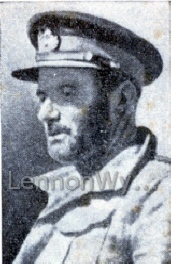
Major General Messervy, Commander 7th Indian
Division.
*
* *
* *
* *
Many successful counter attacks from the box were launched with the West
Yorks by Brigadier G. Evans, of the 5th Indian Division, who commanded
the defence of 7th Admin Box. The offensive fighting which
cleared the Pass was done chiefly by another brigade of the same
division. That left only one brigade to hold the remainder of
its front, including the vital defence of Maungdaw.
*
* *
* *
* *
Throughout these three weeks individual men and units covered themselves
with glory. There were men of the Lincolnshire
Regt., veterans of the last Arakan campaign, who came back to
push southwards at a moment when the situation was most tense.
*
* *
* *
* *
The King's Own Scottish Borderers, after stiff fighting on the
"Able" feature north of the Maungdaw - Buthidaung road, were
among the troops sent to meet the Japanese thrusting southwest from Taung
Bazaar. Punjabis and Gurkhas, meeting the first onslaught
with the K.O.S.B.'s, did valiantly through days of confused
struggles; another battalion of Gurkhas fought and moved
continuously for five days, twice killing large numbers of enemy and
capturing a number of mules.
*
* *
* *
* *
Gunners gave magnificent support over and over again and the 25th
Dragoons, manning the tanks, celebrated their arrival at the right place
at the right time by being concerned in almost every successful
"party." Fuelled and ammunitioned from the air,
they accompanied the infantry on innumerable attacks and offensive
patrols and claimed large numbers of victims with negligible loss to
themselves. In addition, they were used for carrying supplies
from one box to another.
*
* *
* *
* *
Then there were the 700 pioneers - non-combatants - who were hurried from
their normal jobs of road-making airfield construction and similar
"civilian" labour to carry food and ammunition over the
hills. Madrassis, Mahrattas and Bengalis are far from being
hill-men, yet they went over gradients so steep that ropes had to be used.
More than one man lost his life by falling down ravines.
*
* *
* *
* *
Even the Navy (Royal Indian) took a hand. Coastal forces
stood by throughout the action to intercept any Jap attempt to cross the
mile-wide estuary of the Naaf River and land on Indian soil.
Their presence prevented a Japanese commando raid on Taknaf
Peninsula. Enemy concentrating near the coast were dispersed
by naval bombardment.
*
* *
* *
* *
Subedar Karim Khan of the 1st Punjab Reg., led his platoon against a Jap
company, routed it in an hour. It took eight mules to bring
back the captured equipment and supplies. The Subedar led the
frontal attack, got within 10 yards of the enemy, charged.
And his prize souvenir is a fountain pen dropped by a Jap officer.
*
* *
* *
* *
Lt.-Gen. A. F. P. Christison, paid this tribute to his men :
"For the first time British and Indian troops have scored a major
victory over the Japanese. I cannot be too proud of their
magnificent courage and devotion to duty during this difficult
battle."
|
I FLEW
WITH THAT CRAZY CIRCUS
by Paul Chadburn
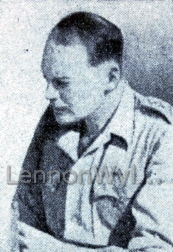
Chadburn "Parade" Reporter
Destruction does not as a rule advertise, especially in jungle
warfare. But the roar of heavy planes rising over our bamboo
bashas that first night east of the Brahmaputra seemed to spell something
fairly considerable bound for the enemy. We were
wrong. Something very considerable was being delivered both
night and day, but it was not bombs and it was not to the
Japs. Hundreds of tons of supplies were streaming over the
Jap positions to keep the Seventh Indian Division fighting in the
Arakan. This is what had happened. On Feb. 5, the
Seventh Indian Division, composed of British Indian and Gurkha troops,
found itself in the position of either having to retreat or stay most
hazardously put.
ACROSS THE PASS
The Japs were across the east end of Nyakyedauk Pass, sole connecting
land link with the div's sources of supply. It decided to stay put
and confound the Jap's knavish tricks of infiltration and encirclement -
tricks which had partially succeeded last year. Our men were
then in much the same position as were the Germans and Italians when they
were boxed up in Halfaya Pass. It was up to the R.A.F. men
and the U.S.A.A.F men composing the Troop Carrier Command of South East
Asia to keep that Division fighting until it could be relieved by
land. So they got cracking. They collected every
available transport plane, every conceivable sort of supply-rations,
fuel, ammunition, spare parts, medical supplies, vast quantities of
parachutes. Besides the crews, volunteers were needed, air
stevedores, to have the supplies overboard from mid-air. An
SOS was circulated among all men of the Seventh Indian Division who for
one reason or another - sickness or leave - had left their unit before it
became encircled.
We volunteered our services, the only way to see what was being done -
they were taking no passengers on the run. We sat on the
bamboo crates with two men of the Division a Yorkshire-man and Londoner,
as the heavily-freighted plane swayed up off the runway and turned
southwards with four others towards the Arakan front. We were
now well within range of Zeros and it seemed at least a point of view
that this "Carter Patterson circus" would be easy
meat. Some of the planes - not ours - had two small machine
guns firing from the removed emergency exists (exits) on either
side. But it was not a formidable armament and bullets would
be deflected by the air-stream. The look-out man was
reassuring. First of all, he pointed to the sky;
there above us were confidence-restoring Hurricanes.
"They give us a cover for the last part of the run," he
told us, "and their patrolling makes the Jap pilot think
twice about getting into the air. The whole supplying force
has only written off one plane so far." He pointed out
of the side window. "That's Buthidaung - Jap pockets all
around there." It seemed to us we were flying very low
considering. It was hilly country, jungle-covered with a good
many clearings in which you could see cattle browsing peacefully.
SHELL BURSTS
Civilian life was going on here as usual, but a couple of miles away
spouts of smoke came out of the ground, probably
shell-bursts. "We'll be dropping the stuff in a few
minutes now." The two wireless operators and air gunners
left the cabin and we scrambled after them over the crates.
From then on during the next half hour everything went "nuts."
The plane seemed to go crazy, rolling and pitching and at intervals
frantically buzzing (the pilot's signal to heave away), the
ground went crazy - it kept on rising against the open doorway
(we'd taken the door off), Bofors guns seemed to be pointing at our
heads like pistols; fore-shortened figures were standing
about on the sides of green precipices; we had gone crazy ourselves
frantically scrambling among the crates, heaving them into piles by the
door, tying them with cords to a fixture in the doorframe and then as the
buzzer wildly and insistently rang out, hurling them overboard into the
rush of the air-stream, where the carefully-tied cord broke and the
parachutes opened. The volunteer from Yorkshire had lashed
himself to the fuselage to stop his body following the bales.
We were stripped to the waist, running with sweat; the bamboo
crates tore your fingers; the lurch of the plane as it rose
suddenly to clear a hilltop (we dropped the supplies from 250
ft.) sent us blundering about like drunks; once, only a
sudden horrible drop enabled us to avoid collision.
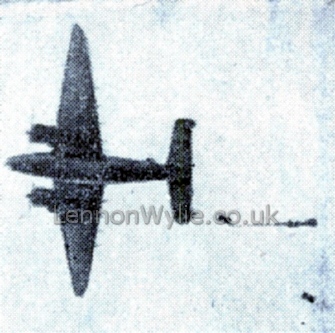
Sailing Down, just before the parachute opens.
CONFETTI
With an escorting Hurricane we began circling erratically; the
turns jerked our hearts into our mouths. Round and round,
following the plane in front that seemed to be behaving so soberly,
sailing round slowly on an even keel .... And what was
happening to the ground or whatever it was that kept on blotting out the
view of same blue sky across the hatch? It looked as though a
Brobdingnagian wedding had taken place and it had been strewn with great
multi-coloured bits of confetti, green, red and black. The
parachutes, of course, the parachutes ... Yes, it was a crazy
circus while it lasted. But to the men who have been on the
game every day - with a night trip thrown in, very often - it was just
routine, just a job, just the part of a job: for they weren't
through when the last bale of ration biscuits and bully, the last load of
shells had snapped their parachute cords. And now there came for our
particular plane the second half of the outing. We had
dropped medical supplies to the cut-off division. But that
was not enough. Casualties had somehow, to be got out of that
embattled patch of Arakan jungle to expect hospital treatment, some of
them to life-saving operations.
IMPUDENT
The Troop Carrier Command comes in on this, too. The
transport planes that delivered the goods to the Seventh Indian Division
loaded up again at a medical staging post on the way back with casualties
who had been nipped out of the beleaguered position in a most impudent
way. Midgets - RAF Moths and American liaison planes - darted
into jungle clearings, seventy-five yards long or less, whisked away the
wounded - often from under the noses of the Japs - and flew them off to
the nearest landing ground for troop transporters. Here it
was that we saw these little life-savers, some of their
pilots. While the stretcher cases were being taken aboard the
D.C. we strolled over to have a shufti at one of the midgets.
A lanky American OR was lolling in the cockpit, scanning that day's copy
of SEAC. Fourteenth Army's own newspaper. Beside him
was a tommy gun. Altogether he looked rather like a commando
- which, in fact, he was: a flying commando of mercy - he was his
own boss, took care of himself, serviced his plane. That
morning he'd flopped down in a jungle clearing a good deal smaller than a
football field, and snatched off a lanky, humorous Londoner in his
arms. By such methods and such men were the "lost"
divisions saved and sustained, and a desperate situation transformed into
a triumph. |
WE
FOUGHT THE BATTLE OF THE BOX - AND WON !
by the Author of
"Infantry Officer"
When John woke me, I sat up and in all seriousness said ...
"Have you got that line through to Delhi yet? I must have it
by this afternoon ..." Then straightening my gun-belt I
climbed past him and dropped into the small trench that constituted our
command post, to take over watch. Hour on, hour off, twenty
four hours a day for more than ten days, and one is apt to see and say
queer things, and, understanding, hear them in others without
remarking. For nearly a fortnight we had literally had our
backs to the wall, and we were tired to death, filthy, often terrified
yet somehow supremely confident. The Japs were going all out
to get a footing on Indian soil, this we knew from captured plans, and we
were not only stopping him, we were giving him as bloody a nose as ever
he has had. Twice he managed to break into the Box, and twice
a handful of Yorkshire-men, supported by tanks, kicked him
out. We wanted him to attack, so that we might kill him the
more easily.
SHEER GUTS
For months now, I have been in the Arakan and I've been able to get a
pretty fair picture of the worth of our men. The thing that
has impressed me most is the way that they have smashed the fallacy that
the Jap is a superman and become acclimatised to the remoteness of the
jungle. Ever since Hong Kong fell, our ears have been filled
with stories of incredible victories gained by the Japanese, and of the horrors
perpetrated by them. How narrow the margin between Hate
propaganda and Fear. But by sheer guts our men held the Jap
and now looked on him as the brute that he is. Now we have
fought him and really taken his pants down and as a result are
justifiably confident in the future and in our superiority.
Of course the Jap is an unpleasant animal, he knows no rules of war, save
to kill the enemy. We took some prisoners and I talked to a
couple. They are not human in my eyes, and they are most
certainly not super-human.
THEY'RE STUBBORN
But let no one run away with the idea that they are not good
fighters. As infantrymen, they are stubborn, hard-marching,
hard-fighting and as tough as nails. They live by the word of
the manual and the pre-arranged plan and that's where we have them
beat. They lack personal initiative and have nothing to
compete with our secret weapon ... common sense. For many
days running the Jap walked in parties into a chaung. In
their original plan the chaung was their rendezvous. The fact
that we held the place had apparently not altered the situation, and so
our chaps had some pretty successful shoots.
MOMENTS ...
I have not been away from the battle long enough to put the happenings of
the past six weeks in their proper order, but there are moments and
people that stick out and are good to remember. Of all those
who fought through those days, perhaps most praise should go to the
doctors of the Field Ambulances. Under the most impossible
conditions they worked and saved men's lives. Once their
hospital was over-run and they had to crawl through the jungle, wriggle
on their bellies out of their tents, over which stood Jap sentries, to
escape. Many failed to get away. They were
mortared and shelled and sniped and the chaung, in which lay the
hospital, was never out of range of even small arms fire. The
two surgeons, unshaved, tired out, wearing blood besmeared rubber aprons,
and looking for all the world like a couple of knackers,
performed miracles of surgery and endurance, with depleted staff and
little equipment. Many scores of good men owe their lives to
these two. Then there was the Yorkshire cook, who managed to
produce two hot meals every day we were in the Box. One day,
during a particularly sharp bout of shelling, I saw him lying on the
ground, protecting with his body a dozen eggs, scrounged from God knows
where. And there was the Gurkha mule driver who wandered into
a battle, seemingly lost. I asked him what were his worries
and he told me that he was looking for some fodder or his Cutcha.
We found some for him and he walked out of the flying mess, quite
oblivious of it all, and only interested in his mule's feed.
One morning four of us played a crazy game. The Jap was
letting us have it fairly hard. Each time we heard a shell
whistle, we tried to judge how close it would fall and duck
accordingly. The idea being that the winner ducked last and
least. So much happened. There was the colonel
who would insist on trying to put out an exploding ammo dump with a spade
and some sand, and when his resultant wounds had been dressed, picked up
his spade and had another crack. And the slit trench that held one
section ... two colonels, a major, a subaltern and three Gurkhas, all
mucking in. Then the officer who spent most of his days sewing
buttons on peoples' trousers and coats.
"THINGS" AT
NIGHT
There was the sensation of almost regret when The Pass was eventually
opened and our immediate fate decided. The nights when one felt
that death was inevitable, and all one's past flooded out to the ears of
the nearest neighbour. The dragging of the eyelids. towards
the end of one's sentry watch. The rum ration that came round
in the early hours of the morning. The incredible
"Things" one saw in the moonlight. I remember
waking John up and getting him to verify something that I had seen
... "About sixty Japs, wiring ..."
That's what I thought, so I called up the bren gunner, and he saw them
too. I hate to admit it, but I let "them" have a
burst and they turned out to be about a dozen bamboo leaves.
ILLUSIONS
Then I saw my whole family sitting about ten yards in front of
me. John saw them too, only they were, in his case, his old
school team. I once saw a six foot Jap cleaning his teeth
inside my post. All of us suffered from these illusions, and
it is a good chit for the discipline and fire control of the troops that
very few cases of shadow shooting occurred. Not it is all
over, the Jap must be a very worried man. He has, without a
doubt, worked out his whole offensive for this year, from China down to
the Bay of Bengal, on the assumption that we would retreat when cut
off. With the troops we now have, and the wonderful support
given by the R.A.F. and the U.S.A.A.F, both in keeping the Jap out of the
sky and in supplying us with food, we need never again withdraw if
threatened from the rear. Stand, and fight, and kill, and
having killed, advance against a depleted and demoralised
enemy. Of all the lessons that February's fighting has taught
us, this is the most important. We have beaten the Jap at his
own game, and we can go on doing it. |
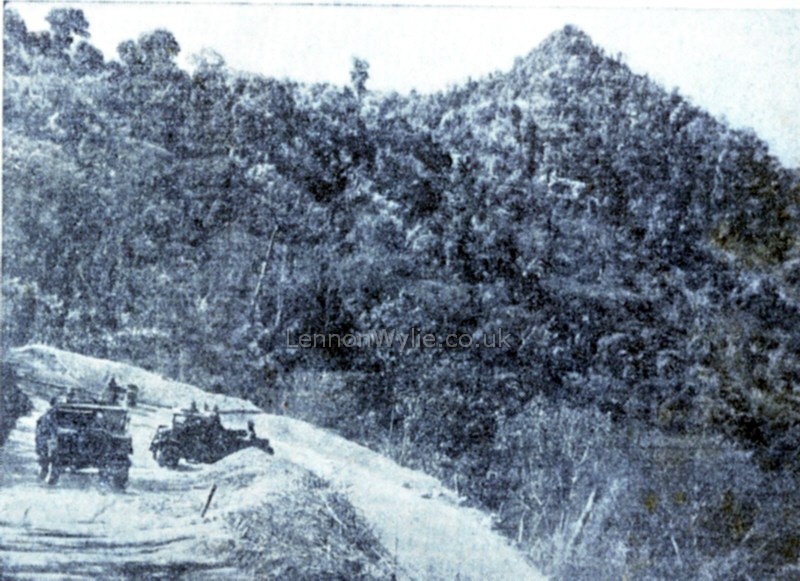
NGAKYEDAUK PASS - One of the bends on
the now famous pass which has seen some of the fiercest fighting of the
Arakan campaign |
| THEY
SWEPT THE SKIES CLEAN OVER ARAKAN
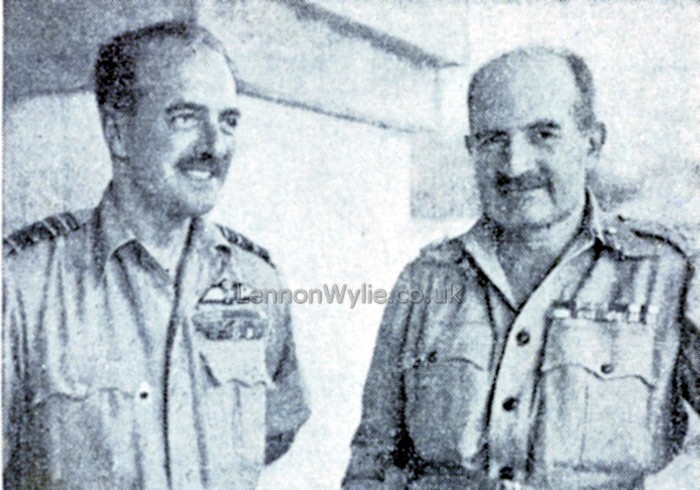
No wonder the Chiefs smile. Air Marshal Sir
John Baldwin, Commander, Third Tactical Air Force and Lt.-Gen. William
Slim,
C-in-C, Fourteenth Army, snapped after the victory
The story of Arakan would not be complete - as the Victory of Arakan
would not have been possible - without the conquest of the skies over
Arakan. This we owe to the R.A.F., I.A.F, and U.S.A.A.F.,
in general. In particular the vital area over the battlefield
was swept clean of the Jap enemy by the dauntless and tireless pilots of
Air Marshal Sir John Baldwin's Third Tactical Air Force. And
when their own special task had been thoroughly fulfilled, the boys in
the Hurricanes, Spitfires, and Vultee Vengeances dived in close support
of Fourteenth Army infantry, engaging targets only 20 yards ahead of the
assault waves. Protection of the Supply dropping squadrons
was the next, and even more essential work of the fighter
pilots. The Allied air fighters not only kept the skies open
to our own troops. They closed skies, roads, and rivers
to the enemy, a magnificent all round achievement. It was the
Fourteenth Army who sent this striking tribute to the Vultee Vengeance
pilots "You've altered the whole face of the
Arakan. Our maps are fast becoming worthless.
You've blasted away so many hill tops that the contours now marked are
just hopelessly out of date." In the R.A.F. they called
it Arakan "Face-Lifting."
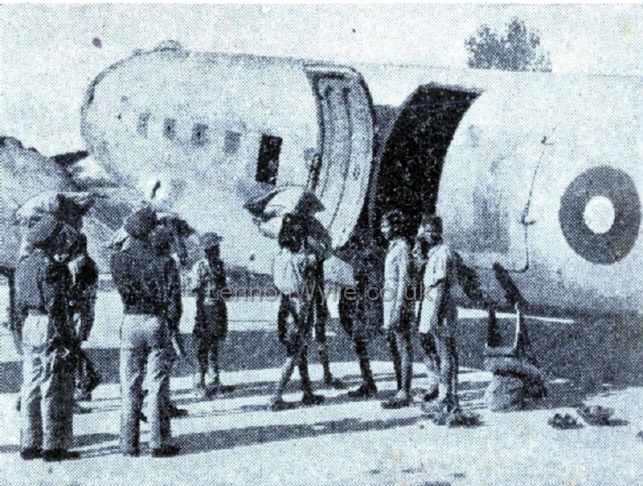
Loading Up. R.I.A.S.C men at a rear airfield
load the transport with supplies
VENGEANCE DIVES
An I.A.F. squadron, flying Vultee Vengeance dive bombers, were reported
by army observers as operating 20 yards ahead of the advancing troops,
diving in such a way that they were pulling out over the Jap lines, not
our own. An I.A.F. Hurricane Squadron earned the title of
"Eyes of the Fourteenth Army." The arrival of the
comparatively slow flying transport craft over the front provided a fresh
incentive to the Japs, well thrashed out of the sky in previous straight
forward scrapping with the British fighters. The story of one
of their most bitter air combats lies behind the recent score of 1
destroyed, 2 probably destroyed and 2 damaged out of 25 Jap fighters
which attacked a supply dropping mission escorted by Hurricanes east of
the Mayu Range. Our losses in pilots were nil.
The squadron was escorting transport aircraft which had just started to
drop supplies when, 3,000 ft. below, they saw 15 plus Jap fighters bust
ground strafing. The Japs immediately climbed to attack and
the Hurricanes dived to intercept. As the supply droppers
were returning to base at 1,500 ft. 10 more Jap fighters made a second
attack on them over Bawli Bazar. (Bazaar) Hurricane squadrons, on Feb 15,
received orders to sink every enemy boat they could spot. The
Hurricanes took up rivercraft busting with relish. So
successful were their efforts that after a day or two the Arakan and
Akyab waterways were practically cleared of sampans and other craft, with
disastrous results to Jap supplies.
TOP COVER
Although patrols for rivercraft busting, strafing enemy positions, and
covering supply aircraft occupied much of their time, the Hurricanes also
accompanied dive-bombers on their missions. At other times,
they provided top-cover for Spitfires re-fuelling after a
combat. As for the Spitfires, as feared over Arakan as ever
they were over Britain, they engaged ceaselessly in patrol over the
battle for six or seven hours a day, dealing with Jap fighters as
Spitfires do.
|
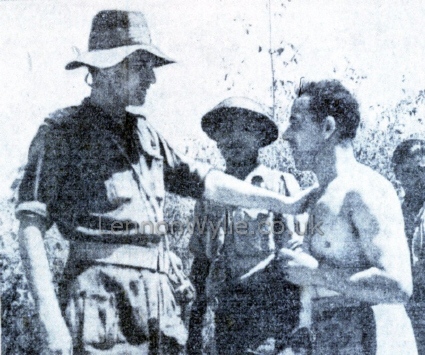 |
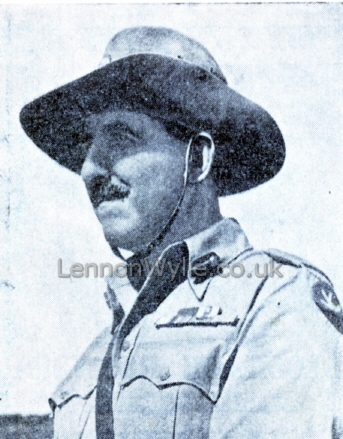 |
| For
This Relief . . . Pictures
by Gidal, of "Parade"
For three weeks men of the 5th and 7th
Indian Divisions were cut off. Under the leadership of
Lt.-General A. F. P. Christison (above right) Commander of the 14th Army
forces in the Arakan, they organised all-round defence.
Other pictures were taken after the relief: Above, left:
Major-General Messervy, Commander of the 7th. congratulates the
cook. Below, left: Tanks advance in swirling heat and
dust against retreating Japs. Below, right: Sikh gunners
pound Peak 1301. Bottom: Victory lunch; tea bully beef and
bread - the bakery kept going all through the fighting. |
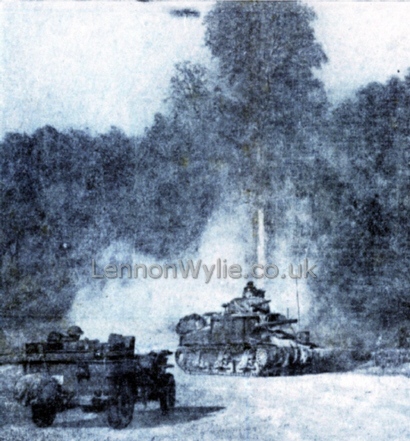 |
 |
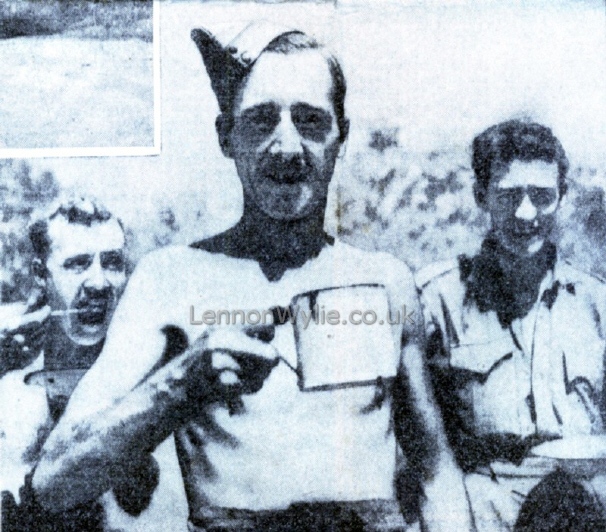 |
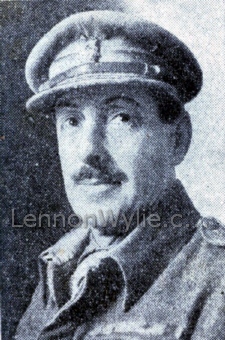
Maj.-Gen. H. R. Briggs, Commander 5th Indian Div. |
|
|
|